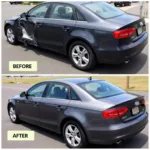Dealing with paint scrapes on your car can be frustrating. Whether it’s a minor scratch from a rogue shopping cart or a deeper gouge from a more serious incident, paint scrape car repair is essential to maintain your vehicle’s appearance and protect it from further damage like rust. This guide will walk you through everything you need to know, from assessing the damage to achieving a professional-looking repair.
Learning how to address paint scrapes yourself can save you significant money compared to professional body shops. Plus, with the right tools and techniques, you can achieve impressive results in your own garage. This guide provides a step-by-step approach to paint scrape car repair, empowering you to tackle those unsightly blemishes with confidence. For more specific instructions on scraped car paint repair, visit this resource.
Assessing the Damage: How Deep is the Scrape?
Before starting any paint scrape car repair, it’s crucial to assess the extent of the damage. The repair method depends on the depth of the scrape. Superficial scrapes that only affect the clear coat are the easiest to fix, often requiring just a bit of polishing. Deeper scrapes that reach the base coat or even the primer require more involved techniques. Examine the scrape closely in good lighting to determine the layers affected.
A simple test is to run your fingernail across the scrape. If your nail catches, it indicates a deeper scrape requiring more than just polishing. Understanding the depth of the damage helps determine the necessary repair materials and approach, ensuring a successful and long-lasting repair. You can find more information on repairing deep scrapes in this guide: how to repair a deep scrape on my car paint.
Gathering Your Paint Scrape Car Repair Supplies
Once you’ve assessed the damage, gather the necessary supplies. For minor scrapes, you’ll need rubbing compound and a polishing pad. Deeper scrapes may require touch-up paint, primer, sandpaper, masking tape, and clear coat. Investing in quality materials will significantly impact the final result of your paint scrape car repair.
Ensure you have the correct color touch-up paint for your car. This information can usually be found on a sticker inside the driver’s side doorjamb or in your owner’s manual. For a complete guide on repairing paint scrapes, check out how to repair paint scrapes on car.
Step-by-Step Paint Scrape Car Repair Process
The paint scrape car repair process involves cleaning the area, applying touch-up paint if necessary, sanding, and polishing. For minor scrapes, start by thoroughly cleaning the area with soap and water. Then, apply rubbing compound to the affected area using a polishing pad in a circular motion. For deeper scrapes, clean the area, apply primer if needed, then carefully apply touch-up paint. Once dry, sand the area smooth and apply clear coat.
Patience and attention to detail are essential for achieving a professional-looking finish. For more information on car scrape paint repair, you can visit this link: car scrape paint repair.
Preventing Future Paint Scrapes
Preventing paint scrapes is always better than having to repair them. Park your car in safe locations away from shopping carts and other potential hazards. Consider using a car cover to protect your vehicle from the elements and minor scratches. Regular washing and waxing can also help protect the paint and make minor scrapes less noticeable.
Conclusion
Paint scrape car repair can seem daunting, but with the right information and a little patience, you can achieve impressive results and restore your car’s appearance. Remember to assess the damage carefully and use the appropriate repair techniques for the best outcome. If you’re uncertain about any step, consult a professional for advice. This comprehensive guide has provided you with the essential knowledge for effective paint scrape car repair, ensuring your vehicle stays looking its best. Check out repair paint scrape on car for additional tips and guidance.
FAQ
- How much does professional paint scrape repair cost? The cost varies depending on the severity and location of the scrape.
- Can I use any type of touch-up paint? It’s crucial to use touch-up paint that matches your car’s exact color code.
- What grit sandpaper should I use for paint scrape repair? Start with a finer grit (e.g., 2000-grit) and gradually move to a coarser grit if needed.
- Do I need to apply clear coat after repairing a paint scrape? Applying clear coat is recommended, especially for deeper scrapes, to protect the repair and restore shine.
- How long does it take for touch-up paint to dry? Drying time varies depending on the type of paint and environmental conditions, typically between 30 minutes to a few hours.
- Can I repair a paint scrape on a plastic bumper? Yes, the process is similar, but you might need specialized plastic primer and paint.
- How can I prevent paint scrapes in the future? Careful parking, car covers, and regular waxing can help protect your car’s paint.
Need help with your car repair? Contact us via WhatsApp: +1(641)206-8880, Email: [email protected]. Our customer service team is available 24/7.

